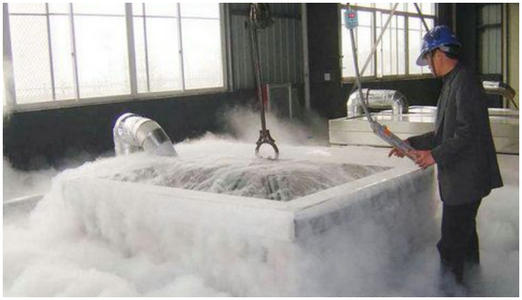Liquid nitrogen in cryogenic treatment
Precision measuring tools and some precision devices, the organization is required to be stable, in use and storage without deformation. Some of the precision measuring tools and devices manufactured by steel have residual austenite after quenching. If residual austenite is not eliminated, these gauges and devices cannot be guaranteed to be deformed. An effective method to eliminate this residual austenite is to cool it, let the residual austenite into martensite, and by tempering it into stable tempering structure.
Some aluminum alloy parts, in the cutting process or long storage, use there is easy to deformation. If the problem of deformation is not solved, it is easy to cause high scrap rate or processing and manufacturing, or the quality of the products sold is not good. These deformation problems are often related to the residual internal stress produced by raw materials or cutting. To solve these deformation problems, sometimes it is necessary to take the method of high and low temperature cycle heat treatment to eliminate residual stress, the towel includes cold treatment -130℃ low temperature cryogenic treatment.
In order to eliminate the residual stress of aluminum alloy parts after quenching, sometimes it is necessary to carry out reverse quenching, that is, the quenched workpiece is cryogenized, and then the workpiece temperature is increased with a faster heating rate, so that it produces the opposite thermal stress when quenching.
Cryogenic treatment
There are also special purpose materials or products that need to be cold or cryogenic treated in order to meet the dimensional stability and safety requirements for use at low temperatures.
Because the temperature of liquid nitrogen is -196℃ and its chemical stability is good, it can be directly or indirectly used in the above cold treatment. Some aluminum alloy parts or steel parts with simple shape and no need to worry about cryogenic cracking and mechanical properties change can be directly immersed in cryogenic treatment in liquid nitrogen. When direct immersion is not possible, volatile gas of liquid nitrogen can be used as the cooling medium. Liquid nitrogen can also be used as a refrigerant to cool the container (cryogenic chamber) in which the workpiece is placed to the desired cold treatment temperature.





 Facebook
Facebook YouTube
YouTube LinkedIn
LinkedIn Twitter
Twitter